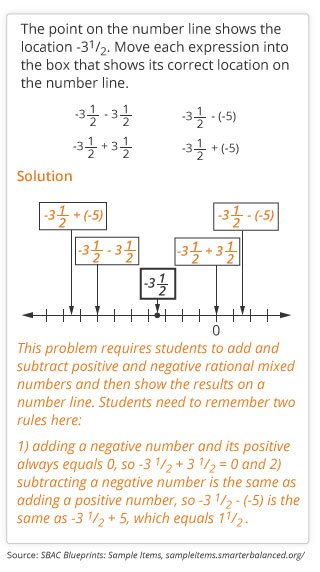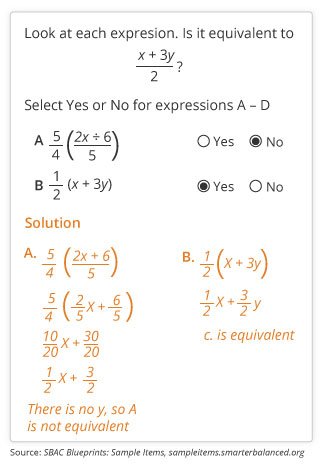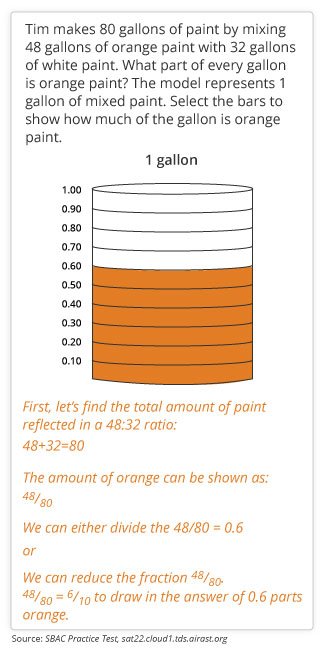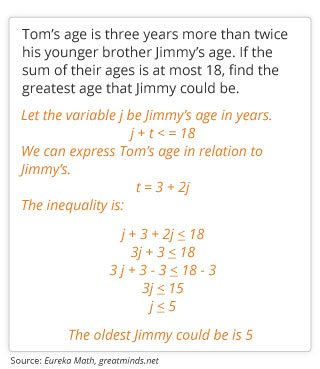Concepts & Procedures
What they're learning
Seventh grade teachers do some heavy lifting. They begin to move students from arithmetic to algebra or, to put it another way, from learning about numbers to learning the mathematical reasoning that explains the relationships between numbers.
Students continue learning procedures, or how to solve problems, as well as the concepts behind those procedures, which is why they work.
Students need to understand the fundamentals of rational numbers. (Let’s set aside that the words middle schoolers and rational aren’t usually found in the same sentence.) Seventh graders need to know how to apply the four operations (+,-,x,÷) to all types of numbers within the rational number system, which includes any positive or negative whole number or decimal that can be expressed as a simple fraction. (Knowing what the rational number system includes helps you sound like an expert when badgering your children about their homework!)
Here’s where it gets a little complicated — no, make that exciting: a decimal that can be expressed as a fraction (including repeating decimals such as .333, which is 1⁄3) is rational, but a decimal that goes on forever (non-repeating) and can’t be expressed as a fraction, such as the square root of 2 or the mighty pi, Π, are known as irrational, but more on that in eighth grade. For now, focus on rational numbers.
In seventh grade, students continue to add, subtract, multiply, and divide, but now they are expected to be able to do this with all rational numbers — positive and negative numbers, fractions, and decimals. Students also have to be proficient at understanding and finding different representations of rational numbers, including converting decimals to fractions, fractions to decimals, and converting both fractions and decimals to percents. Students then need to show their understanding of rational numbers by solving word problems involving rational numbers.
Watch how seventh graders add and subtract with rational numbers.

In seventh grade, students learn new rules, procedures, and properties that they use to create and solve equations with negative numbers and variables. For example, adding a negative number to its positive (e.g., -4 + 4) always equals 0; the product of two negative numbers is always a positive number (-6 x -7 = 42); and the product of a negative number times a positive number is always a negative number (-8 x 6 = -48).
In sixth grade, students learned that a ratio is a way of comparing numbers, units, or quantities, such as running one mile in 6 minutes, 2 miles in 12 minutes, etc. These are known as proportional relationships. Seventh graders learn to use both fractions and decimals to display these relationships. They learn to test these relationships by modeling them on a chart, number line, table, or graph to show whether they really are proportional. If they are proportional, kids should be able to create an equation that represents the relationship.
Here’s an example of a proportional relationship turned into an equation. It’s based on running 1 mile in 6 minutes. If x equal miles and y equal minutes, this relationship would be written as 6x = y.
In addition to writing and solving equations with variables (ex: 2x + 4 = 12), seventh graders work with inequalities using greater than (>), greater than or equal to (≥), less than (<), and less than or equal to (≤). For example, say a salesperson is paid $50 per week plus $3 per sale, and this week the salesperson wants his pay to be at least $100. With x representing the number of sales, an inequality showing this might be $50 + $3x ≥ 100.
Sample problems
Adding, subtracting, multiplying, and dividing rational numbers
Sample problem 1: Adding and subtracting rational numbers

See how seventh graders explain the relationship between positive and negative numbers.

Representing proportional relationships of ratios
Sample problem 2: Using pictures to work with ratios/proportional relationships
Sample problem 3: Using tables, graphs, and equations to work with proportional relationships/ratios

Using the distributive property to simplify equations
Sample problem 4: Simplifying expressions to determine equivalence

Solving problems involving equations and inequalities that have variables
Sample problem 5: Solving inequalities
If your child didn’t meet the concepts and procedures standard…
- Your child may have difficulty adding, subtracting, multiplying, or dividing rational numbers (which includes whole numbers, fractions, and decimals, both positive and negative). (See sample problem 1.)
- Your child might not understand the concept of proportional relationships or how to represent them on graphs, tables, or using pictures. (See sample problems 2 and 3.)
- Your child may find it challenging to simplify expressions using the distributive property. (See sample problem 4.)
- Your child may have trouble solving problems involving equations and inequalities that have variables. (See sample problem 5.)
Start with a great attitude
Seventh graders encounter a lot of negative numbers, but remember to keep everyone’s attitude toward math positive. Research shows that your good attitude toward math will improve your child’s attitude — and his performance in math.
Sprinkle math into everyday activities
- Quiz each other about scenarios in which a positive and a negative combine to equal zero. For example, I earned $10 and then I bought a $10 T-shirt. Yep, you’re left with zero. I poured myself eight ounces of water and then drank eight ounces. Zero again. I drove two miles to school and then drove two miles back. This one’s a trick! You didn’t drive zero miles, you drove four! See how many you can think of together.
- Get your child in the habit of estimating. What time will we arrive at school? How much will lunch cost? How many bottles of water should we buy for the soccer game? Being able to make reasonable estimates is a skill that will serve her in and out of math class.
Boost those skills
- Histograms? Scientific notation conversions? Let Be a Learning Hero help your seventh grader build these and other skills with these 37 games and activities.
- Check out this funny video introducing the concept of ratios by the Art of Problem Solving.
- See a simple explanation of what happens when you subtract a negative number from another negative number and (hopefully) never be confused again!
Talk to your child’s teacher
In middle school, it can be tougher to schedule time to talk to all of your child’s teachers, but it’s worth it! The best way to start a conversation with your seventh grader’s math teacher is to ask questions such as, What are the most important things my child should learn in your class this year? and What are typically the toughest concepts? What should I be on the lookout for in my child’s homework to make sure he’s getting it? Be ready to take notes on what the teacher says. When you talk about specifics, it’s easier to ask for resources, tips, and ideas on ways you can help your child.

